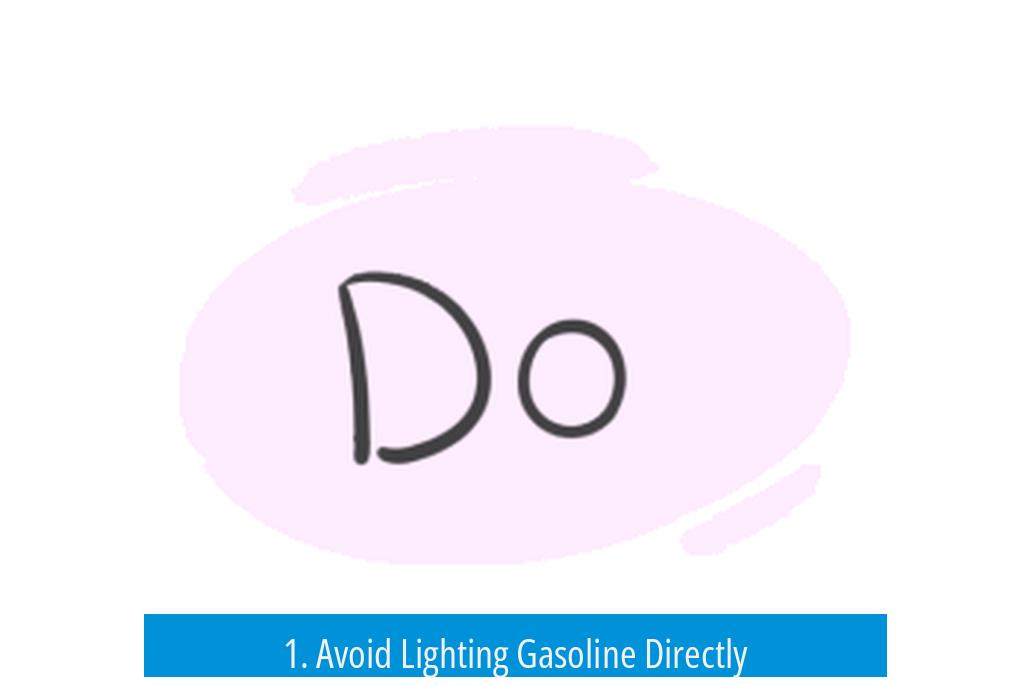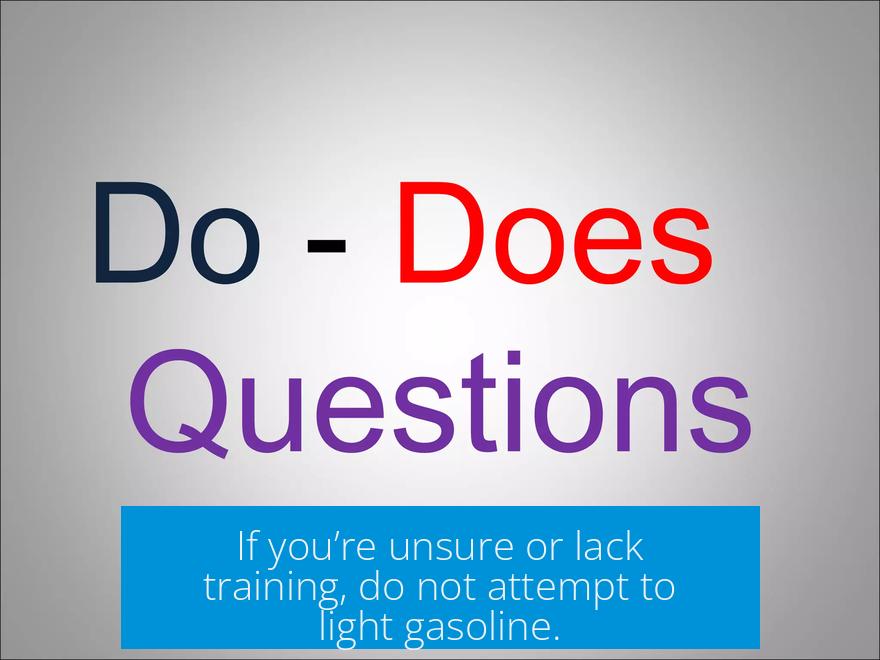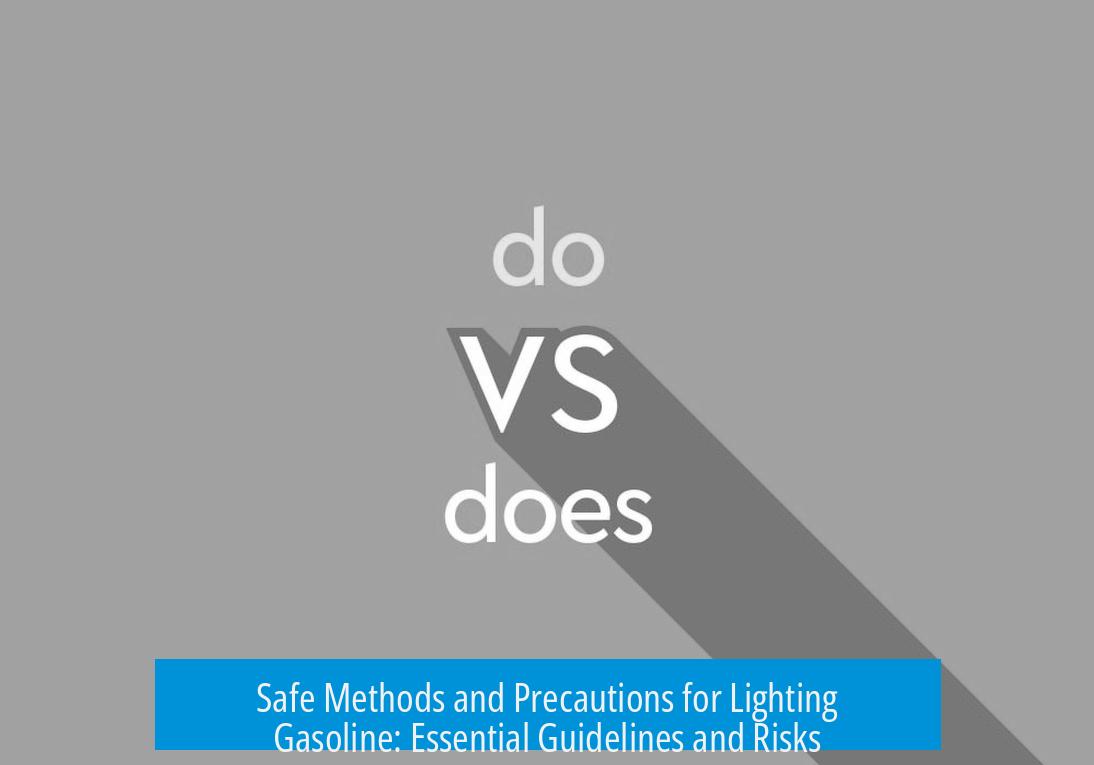How Do I Safely Light Gasoline?

Lighting gasoline safely is extremely dangerous and generally not recommended for amateurs. If necessary, it requires strict precautions: minimal fuel amounts, remote ignition from a safe distance, protective gear, area clearance, and fire control tools. Professionals avoid gasoline in favor of safer materials.
1. Avoid Lighting Gasoline Directly

Gasoline is highly flammable and unpredictable. Experts strongly advise against igniting gasoline outright. Ignition can lead to rapid fire spread or explosions, causing serious injury or legal problems. Professionals never use gasoline for pyrotechnics or fire effects due to its volatile nature.
- Gasoline ignites easily and burns intensely.
- There is a significant risk of fire spreading uncontrollably.
- Obtaining or using gasoline igniters without expertise may be illegal.
If you’re unsure or lack training, do not attempt to light gasoline.

2. Safer Alternatives to Gasoline
Various substances create fire effects with less risk than gasoline. Powders and controlled fuels provide safer options for fireballs or pyrotechnics.

- Powdered coffee creamer: Creates a safe, effective fireball when blown into flames.
- Corn starch: Used in controlled pyrotechnics to create fire effects safely.
- Lycopodium powder: Preferred for reliable fire effects but less accessible.
- Flour or sawdust: Small quantities blown near flames produce fire bursts without fuel runoff.
Consider alternatives before resorting to gasoline ignition.
3. If Insisting on Using Gasoline: Essential Safety Steps

3.1 Use Minimal Fuel and Proper Application
- Begin with very small amounts (~5 mL) of gasoline.
- Avoid pouring gasoline directly into or near fire.
- Prefer spraying gasoline as a fine mist for controlled fireballs.
Pouring large volumes increases risk of uncontrollable burns or fire spread.
3.2 Remote Ignition and Distance
- Ignite gasoline vapors remotely from at least 100 feet behind a solid cover.
- Consider a setup with compressed air injection through a buried tube under the fire.
- If handling manually, throw a small gasoline quantity from 10 feet away using a non-breakable container.
3.3 Environmental Safety
- Clear a 300-foot perimeter of flammable materials around fire site.
- Wet the entire surrounding area prior to ignition to prevent unintended fires.
- Keep fire extinguishers and water available and ready.
- Avoid gasoline trails leading back to containers or outside the controlled zone.
3.4 Protective Gear and Fire Control
- Wear heavy clothing: jacket, jeans, gloves with no exposed skin.
- Use face protection such as a welding mask if possible.
- Ensure good ventilation and contain fire in a metal barrel or pit below ground level.
- Practice emergency fire procedures and the stop-drop-roll technique before ignition.
3.5 Ignition Method
- Ignite gasoline vapors, not liquid pools: create a vapor trail 10-15 feet long.
- Use a match dropped onto the vapor trail rather than a lighter flame directly on liquid gasoline.
4. Real-World Risks and Anecdotes
Gasoline fires can escalate rapidly with even slight wind changes. Explosions may send debris flying at high velocity. Many have suffered severe, life-altering burns from mishandled gasoline ignition.
Such fires do not self-extinguish quickly, increasing hazards substantially.
5. Professional and Legal Considerations
Special effects professionals do not use gasoline. They employ propane, diesel fuel mist, or black powder charges combined with safer fuels. Legal restrictions often forbid homemade firebomb devices.
Certification, professional guidance, or use of computer-generated effects (CGI) is strongly advised over direct gasoline use.
6. Summary Checklist for Safe Gasoline Ignition
- Use very small gasoline amounts, start at ~5 mL.
- Do not pour gasoline; spray as a fine mist or inject remotely.
- Ignite remotely from ≥100 feet behind cover.
- Clear and wet a 300-foot fire zone perimeter.
- Wear full protective clothing and face shield.
- Have fire extinguishers and water ready.
- Keep gasoline away from the ignition site.
- Use matches on vapor trails, avoid lighter on liquid.
- Practice fire emergency safety in advance.
- Consider safer alternatives before proceeding.
Key Takeaways
- Lighting gasoline is inherently hazardous and should be avoided
- Use safer fire effect materials such as powders or propane
- If absolutely needed, follow strict safety steps for minimal exposure
- Remote ignition, protective gear, and fire control are mandatory
- Professional consultation or alternatives like CGI is the best route
How Do I Safely Light Gasoline? The Straight Talk You Need
Simply put: you don’t. Gasoline is not a friendly fire starter. It’s a volatile, risky, and unpredictable beast that professionals avoid like the plague. If you’re reading this because you’re curious or maybe plotting a small homemade fireball, take a step back. It’s better to steer clear or choose safer options.
Still here? Let’s break down the *real* deal on lighting gasoline safely, what the experts say, alternatives you’ll actually want to try, and the black-and-white don’ts that might just save your eyebrows (or worse).
The Big No-No: Why You Shouldn’t Light Gasoline Directly
Gasoline is wildly flammable—so much so that handling it for fire lighting is a recipe for disaster. It’s not just about getting a fire going; it’s about controlling it. And with gasoline, control evaporates faster than you can say “flame on.” Professionals in pyrotechnics steer clear, opting instead for propane or diesel mist. Want to know why?
- Gasoline ignites nearly instantly, often causing sudden flare-ups and fiery explosions.
- Pouring gasoline directly onto a fire leads to burning liquid spreading, increasing risk dramatically.
- The fumes travel—sometimes creating trails of fire that race back to your gasoline container.
- Legal risks abound. Constructing devices that fling gasoline flames can be considered making firebombs. Serious trouble there.
One blunt safety truth: if you found this question on Reddit, that’s your sign to back away.
Safer, Cooler Ways to Get That Fireball Without Gasoline
If you’re after the visual fireworks effect, you don’t have to play with liquid fire. Let’s talk alternatives.
- Powdered coffee creamer: Sounds odd? Maybe. But it’s less flammable and can produce neat fireballs when tossed into a fire.
- Corn starch or flour: A handful tossed into flames creates a cool flash effect with way less danger.
- Lycopodium powder: This is a step up for true pyrotechnic effects, but it’s pricier and trickier to find.
- Sawdust: Small burns, dramatic “whomp” sounds. Remember not to use on windy days or near dry brush.
DIY pyro enthusiasts rave about these? They’re safer and more controllable than the gasoline nightmare.
If You Absolutely Must Use Gasoline: The Extreme Caution Guide
First, the glaring disclaimer: not recommended. But if you’re adamant about it, be prepared and respect the danger like never before.
The Dos and Don’ts of Handling Gasoline for Fire Effects
| Aspect | Safety Tips |
|---|---|
| Amount | Start tiny—around 5 mL of gasoline. Anything more and you’re just begging for trouble. Pouring 200 mL? That’s a firestorm waiting to happen. |
| Application | Spray as a fine mist into flames rather than dumping liquid. This creates a flamethrower effect instead of a liquid pool fire. |
| Ignition Distance | Ignite from 100 feet away behind solid cover. Push the gasoline via a buried tube and compressed air into the fire to keep your distance. |
| Fire Area Preparation | Wet down a 300-foot radius to eliminate flammable debris. Keep a water hose and powder-based extinguisher at the ready. |
| Protective Gear | Wear heavy jackets, gloves, jeans—no exposed skin. If you’ve got a welding mask, use it. Ventilate well and consider burning below ground level or inside metal barrels. |
| Ignition Method | Light gasoline vapors, not liquid, with a carefully dropped match. Avoid lighters—one spark too close and you could lose a finger. |
Above all, rehearse “stop, drop and roll” before starting. It might sound dramatic, but if your clothes catch fire, it’s a lifesaver. Have at least one bystander ready to assist.
Real Stories? Yeah, Be Ready
Litters of caution aside, gasoline fires are notorious for turning deadly in seconds. They don’t just burn out. They keep flaming. A sudden breeze can blow your flame anywhere.
People who ignored warnings often ended up with terrible burns or worse. Objects launched by explosions have caused serious injuries. This is not a fear-mongering tale—it’s fire science.
Want It Done Right? Get a Pro or Use CGI
Think you can DIY pyrotechnics without trauma? Think again. Professionals with certifications handle this stuff. They use safer fuels like propane or diesel mist paired with black powder bursting charges for controlled fireballs.
Best advice? Unless you are a licensed pyro technician, hire someone or create the effect digitally. Modern CGI fireballs look amazing and carry zero risk.
Your Ultimate Safety Checklist Before “Lighting Up”
- Start with minimal gasoline (5 mL or less).
- Never pour gasoline directly onto a flame; use spray or remote injection.
- Keep ignition remote — at least 100 feet behind cover.
- Clear and wet a 300-foot radius around the fire zone.
- Wear heavy protective clothing, gloves, and face shield.
- Set up fire extinguishing equipment before lighting.
- Keep gasoline container far from the fire area.
- Ignite vapor trails with matches, not lighters.
- Make sure all bystanders know stop, drop, and roll.
- Seriously consider safer alternatives before attempting.
Words to Live (and Burn) By
- Don’t do it.
- This is not safe without expert training.
- Adding gasoline to fire is just begging for trouble.
- If you want fireworks, get creative with safer materials or CGI.
- This isn’t a chemistry test. Ask pyrotechnics pros.
- I am not a pyrotechnics expert. You do all this at your own risk.
Helpful Resources
- Cautionary video about lighting gasoline fires. Watch it before you light that match.
- Search for Uncle Rob’s gasoline safety videos; he’s got solid, down-to-earth advice.
Final Takeaway
The bottom line? Lighting gasoline is a loaded dice game with your safety on the line. It’s best to leave it alone or hand off the job to professionals. Safer powders, propane setups, or CGI effects deliver drama without disaster.
Thinking twice isn’t just smart; it could save your life. Fire is beautiful, powerful, and unforgiving. Treat gasoline like the wild card it is. Don’t get burned in pursuit of a flame.
How can I safely ignite gasoline vapors without risking a large uncontrolled fire?
Light only the gasoline vapors, not the liquid. Create a thin gasoline trail about 10 to 15 feet long and drop a match at the far end. Avoid using lighters for direct ignition to reduce risk.
What safety measures should I prepare before attempting to light gasoline?
- Wet surrounding areas within 300 ft and clear flammable materials.
- Wear heavy clothing, gloves, and consider a welding mask.
- Keep fire extinguishers nearby and rehearse emergency fire control steps.
Is there a safer alternative to using gasoline for creating fire effects?
Yes. Use powdered coffee creamer, corn starch, or lycopodium powder instead. These powders create fireballs but are much safer to handle than gasoline.
How should gasoline be applied if I must use it for ignition?
Use very small amounts—start with about 5mL. Spray it as a fine mist into the flame rather than pouring liquid. Do not pour large volumes directly to avoid dangerous burns and spreading fire.
How far should I be when igniting gasoline, and what setup increases safety?
Ignite remotely from at least 100 feet away behind cover. Use a buried tube or compressed air system to inject gasoline into the fire. Avoid standing close or pouring gasoline directly onto flames.





Leave a Comment